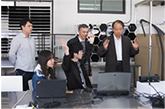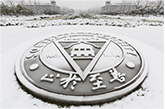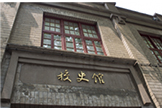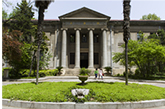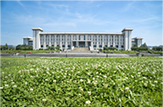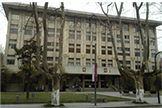He was born in a legendary family. His father, Tong Jun, was a master of Chinese architecture, known as one of the “Four Masters of Chinese Architecture” together with Liang Sicheng, Yang Tingbao and Liu Dunzhen. His uncles werealso well-known motor expert and microbiologist respectively. He has two sons who have also made remarkable achievements. The elder son Tong Wen is the chief scientist of Huawei 5G and the second son Tong Ming is serving the Planning Department of Tongji University as a professor.
He’s devoted all his life to the country and the national development. After graduation from the Department of Physics of Peking University in July 1955, he firstly participated in the neutron bomb research program led by the team of Qian Sanqiang and He Zehui, and was then transferred to Nanjing Institute of Technology (currently Southeast University) as a teacher where he plunged into the research of electron beam physics and technology. In the 1980s, he took the lead in the researches on the localization of television picture tubes.
Tong Linsu is known as a famous expert in physical electronics, a pioneer in the field of display science and technology in China, a professor and a doctoral tutor of the School of Electronic Science and Engineering of Southeast University. As the strict father in the eyes of his sons and the rigorous teacher in the eyes of his students, he died in Nanjing on April 2 at the age of 87.
He still concerned the cutting-edge dynamics in the field of physics until the last moment of his life.
Even he was 87 years old, Tong Linsu still paid attentions to the hot topics nowadays. Despite ups and downs in his life, his every step well matched with the turning points of national development and development of the era.
“When I saw him the last time, he still cared about the cutting-edge dynamics in the field of physics.” Tong Linsu’s elder son Tong Wen recalled that his father’s enthusiasm for artificial intelligence impressed him mostly. “He told me that the knowledge gap of all people can be filled up if humans’ all knowledge can be stored in the brain; then we are prone to cultivate more outstanding talents.”
Tong Linsu was born in Shanghai in December 1933. As a boy greatly interested in mathematics and physics from childhood, he was then admitted to the Department of Physics of Peking University. During his studies, he oncelearned from famous Chinese physicists including Zhou Peiyuan, Hu Ning and Wang Zhuxi. After graduation from Peking University in July 1955, he joined in Dalian Naval Base of the Chinese People’s Liberation Army and became a member of China’s first nuclear submarine development team. He then participated in the neutron bomb research program as led by Qian Sanqiang and He Zehui’s team. In 1957, He was transferred to Nanjing Institute of Technology (currently Southeast University) as a teacher.
In the impression of Tong Ming’s childhood, the second son, his father was always busy and rigorous. “Around 1975, my father often went to Beijing for business trips. Even at home, he always kept himself at home to study his subjects. He was very punctual and felt unhappy with a little lateness”.
Such dedication and cherishing time like gold enabled Tong Linsu to gain extraordinary achievements. Since 1975, Tong Linsu has hosted several projects including the national joint design project of 31cm black-and-white picture tube, the 10cm black-and-white flat picture tube and TV project, the new high-resolution color picture tube project (the key project of foreign intelligence leadership team as introduced by the State Council in 1988), and the 1000 line single color internally biased picture tube project, etc..
In June 1983, the twelve-inch flat picture tube studied by his research team featured half size and could reduce the power consumption by half. The dry batteries could be used directly. At that time, if all 20 million television sets in China adopted such flat picture tubes, enormous electricity power could be saved. “His early pursuit of portable and economic power consumption display is the core objective of the development of various new display technologies today”, said Zhang Yuning, Director of the Display Technology Research Center of Southeast University.
Tong Linsu has participated in and hosted the evaluation of 22 large-scale color picture tube projects in China ever since 1987, which have saved more than RMB 1 billion investments for the country. Upon technological changes of several generations, the information display has become one of the pillar industries of China’s electronics industry. He has carried out original researches in the field of in-tube deflection-type tubes and solved the problems of outgassing in vacuum, high voltage isolation of in-tube deflection coils and pre-correction of screen grating, etc., and thus developed the international first black-and-white and color internally-biased picture tube. This achievement was rated as one of the world’s eight new technologies regarding color picture tube in 1997 by Stanford International Research Institute, the international authority in this field.
Make your research direction in conformity with the country’s demands.
“Teacher Tong has opened an international perspective for us very early and set a precedent for international cooperation in colleges and universities. As for how to cooperate with foreign enterprises and how to deal with intellectual property matters, I began to deal with such issues when I was studying for the Ph.D. degree after Teacher Tong”, said Zhang Xiaobing, a doctoral student of Tong Linsu in 1993 and right now serving Deputy Dean of the Research Institute of Southeast University. Upon investigation and exchanges for many years, the team led by Tong Linsu signed a cooperation agreement with Philips in 1994 to establish SEU-Philips Display Tube Technology Research and Development Center. Both parties have been cooperating for more than 25 years. Relying on the development of this center, the Display Technology Research Center of Southeast University has become one of the first batch of international cooperation joint laboratories as approved by the Ministry of Education.
“Teacher Tong insisted on going to the office every day to read literature, review papers and communicate with us even two or three years ago. He was always obsessed with the latest display technology. Every time when we evaluated the quality of display screen image, he was always the eldest tested object”, Zhang Yuning said.
In his youth, Tong Linsu sought survival and improved his studies in social turmoil; but he was always upholding a faith: “No matter what happens, you should study hard and make your research direction in conformity with the national demands so as to promote the national progress while handling the relationship between study and real life properly”.
Tong Wen, an academician of Canadian Academy of Engineering, the wireless CTO of Huawei Company and the chief scientist of 5G, once felt perplexed in senior high school when the matriculation had not yet been resumed. “My father once talked to me several times. He said that no matter what would happen in the future, you have to go to college and lay a good foundation in mathematics and science.” Tong Wen said that Tong Linsu encouraged him to apply what he would learn into practice when choosing the major. Later he chose the major of radio and has been long engaged in telecommunication researches after his Ph.D. graduation.
(Jin Feng)
April 9, 2020 [Science and Technology Daily] Version 05





